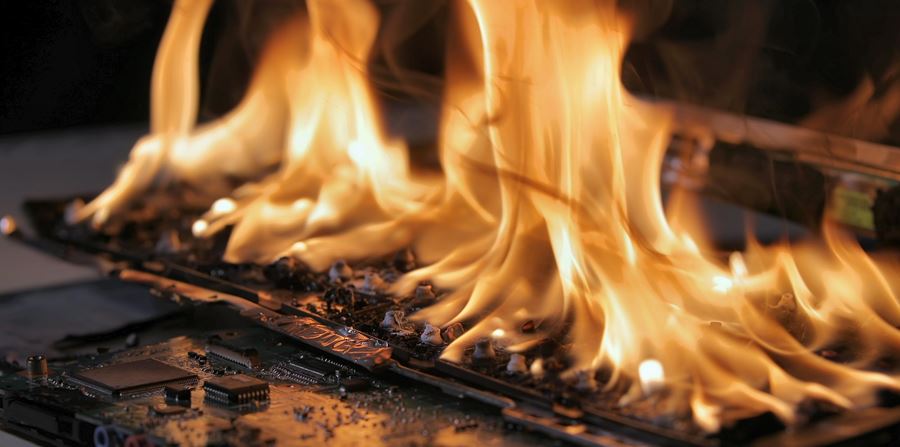Lithium Battery Fires: 10 Safety Tips for Fire Prevention

The use of lithium batteries has seen a massive increase over the last five years; it seems that every electronic device now uses this type of battery. The lithium-ion battery can pack a bigger punch in a smaller package, making it appealing to manufacturers who are trying to concentrate power into smaller packaging. Due to this increased use, we have seen an uptick in fires and injuries from lithium batteries.
Since there can be some confusion between different battery types using lithium chemistry, let’s start by breaking down these batteries into two categories: primary and secondary. Then we’ll dive into what happens when a battery malfunctions, and how to help prevent a battery-related fire.
- Primary (non-rechargeable) lithium batteries are comprised of single-use cells containing metallic lithium anodes. Non-rechargeable batteries are referred to throughout the industry as “lithium” batteries. You can find these types of batteries in computers, various machines that have the need to save settings, long use devices, such as the 10-year battery life smoke detectors, and devices that have higher performance demands, such as some cameras and flashlights (123A batteries for example). Do not recharge these.
- Secondary (rechargeable) lithium batteries are comprised of rechargeable cells containing an intercalated lithium compound for the anode and cathode. Rechargeable lithium batteries are commonly referred to as lithium-ion or lithium-polymer batteries and are commonly used in almost all of your consumer items that are currently labeled as rechargeable.
Why do Lithium Batteries Catch Fire?
Most fires that occur from lithium batteries are due to thermal runaway. A thermal runaway happens when conditions are met that cause reactions to occur and cannot be easily stopped. These reactions are exothermic, meaning that they give off heat, and that heat may be enough to cause a fire.
We know that physical damage or electrical abuse, such as short circuits, overcharging, and exposure to elevated temperatures, can cause a thermal runaway. Additionally, manufacturer defects, such as imperfections and/or contaminants in the manufacturing process, can also lead to thermal runaway.
Thermal Runaway in Lithium Batteries
During thermal runaway of battery, a reaction can occur, which vaporizes the organic electrolyte and pressurizes the cell casing. If, or when, the case fails, the flammable and toxic gases within the cell are released. Once a thermal runaway starts, the process cannot be stopped, even by unplugging the battery. Even worse, you may not know when this runaway starts. Therefore, it is best to make sure that the battery is being charged in a safe place where other fuels will not be ignited.
To minimize the possibility of thermal runaway the battery, charger, and device manufacturers use battery management systems to make sure that the batteries are operated within a voltage, current, and temperature range that is considered safe. For example, if a lithium-ion powered device says the battery is dead and the device will not operate, the actual battery is not dead, instead, it has reached the lower level of safe operation and a good management system will not allow the use of the device.
How to Prevent Lithium Battery Fires (10 Tips)
There are a few things we can do to prevent lithium batteries from causing damage to our homes or businesses and injuring those nearby.
- Only buy batteries that are from reputable manufactures.
- Do not charge non-rechargeable batteries.
- Keep batteries away from high temperatures.
- Do not keep batteries on a charger once the charging cycle is completed.
- Only charge batteries when you are home or present to monitor the process.
- Use only the charger that came with the battery or a battery that is listed by the manufacturer as compatible with the battery.
- If possible, try to charge a battery in a fire-safe charging bag.
- When storing an item with a lithium-ion battery, remove the battery from the item if possible.
- Inspect batteries when they are first installed and after charging if possible. If you notice damage to the battery, do not recharge it.
- If you feel excessive heat coming from the charging device, remove the item from the power source and place it away from and combustible items until it has cooled down. Call the fire department if needed. Replace the battery as soon as possible.
These few precautionary steps are a simple way to prevent fires and damage from lithium battery failure, and it is important to practice safety measures when dealing with lithium batteries due to their flammable nature.
Nuestros consultores están listos para ayudar.


